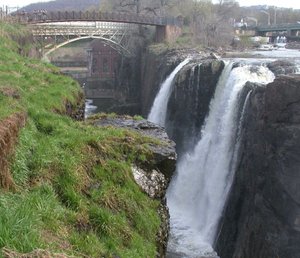Passaic River
|
|
The Passaic River is a tributary of Newark Bay, approximately 80 mi (129 km long), in northern New Jersey in the United States. The river in it upper course flows in a highly circuitous route, meandering through the swamp lowlands between the ridge hills of rural and suburban northern New Jersey, draining much of the northern portion of the state through its tributaries. In its lower portion, it flows through the most urbanized and industrialized areas of the state, including along downtown Newark. The lower river suffered from severe pollution and industrial abandonment in the 20th century, but has begun to recover in recent decades.
| Contents |
Description
The Passaic rises in the boro of Mendham, in southern Morris County. It initially flows generally south, through Morristown National Historical Park, and forms the boundary between Morris and Somerset counties. It passes along the eastern edge of the Great Swamp, which it drains through several small tributaries. Northwest of Warren it turns abruptly northeast, flowing through the valley between Long Hill to the west and Watchung Mountain to the east.
Near Chatham it turns north, forming the boundary between Morris and Essex counties. It passes Livingston and West Caldwell, where it flows through the Hatfield Swamp and is joined by the Rockaway River. Southwest of Lincoln Park it passes through the Great Piece Meadows, where it turns abruptly eastward and is joined at Two Bridges by its major tributary, the Pompton River.
It flows northeast into the city of Paterson, where it encounters the Great Falls of the Passaic, below which it becomes navigable. On the north end of Paterson, it turns abruptly south, flowing between Paterson on the west and Garfield on the east, then through the city of Passaic, then pasing Rutherford, Lyndhurst, Nutley, Belleville, and North Arlington, New Jersey.
In its lowest reaches, it flows along the northeast side of the city of Newark, passing Kearny and Harrison, New Jersey on the opposite bank. Near downtown Newark it makes an abrupt northwest bend, then south, joining the Hackensack River at the north end of Newark Bay estuary, a back bay of New York Harbor.
History
DSCN3836_passaicriverinwesternessexco_e.JPG
Starting in the late 18th century, the river was highly significant in the early industrial development of New Jersey, providing a navigable route connected by canals to the Delaware River. It was also an early source of hydropower at the Great Falls of the Passaic in Paterson, resulting the early emergence of the area as the center of industrial mills..
Much of the lower river also suffered severe pollution during the 19th and 20th centuries. Although the health of the river has improved due to legislation and the decline of industry, the river still suffers from substantial degradation of water quality. The sediment at the mouth of the river near Newark Bay also remains contaminated by such pollutants as dioxin.
The decline of manufacturing on the lower river has also left a post-industrial landscape of abandoned and disused factories and other facilities. In particular the stretch of the river along downtown Newark came to be regarded in the later decades of the 20th century as particularly wretched. Starting in the 1990s, the lower river became subject of federal and state urban restoration efforts which have resulted in new construction along the riverfront, including a regional headquarters of the FBI.
Tributaries
(As encountered travelling upstream):
- First River (a.k.a. Mill Brook)
- Second River
- Third River
- Saddle River
- Fleischer Brook
- Little Diamond Brook
- Goffle Brook
- Molly Ann Brook
- Slippery Rock Brook
- Peckman River
- Deepavaal Brook
- Pompton River
- Rockaway River/Whippany River
- Foulerton's Brook
- Spring Garden Brook
- Slough Brook
- Canoe Brook
- Cory's Brook
- Dead River
- Black Brook
- Great Brook
- Penns Brook
- Indian Grove Brook
See also
External links
- Lower Passaic River Restoration Project (http://www.ourpassaic.org/)

